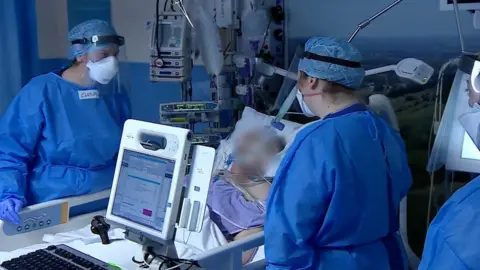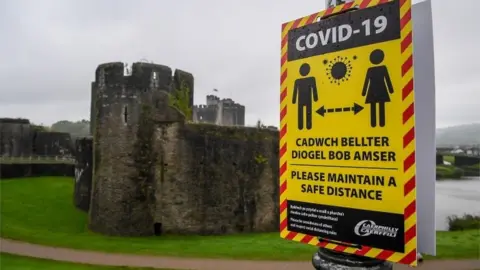Covid-19: Why has Wales chosen a national lockdown?
 PA Media
PA MediaPembrokeshire in the far west of Wales has one of the lowest case rates for coronavirus in the whole of the UK, at 43.7 per 100,000 people.
It is ranked just 353rd out of 377 UK local authority areas, and is only beaten by Ceredigion for having the lowest rate in Wales.
Jump across to Cardiff and the picture is very different. The rate is more than six times higher at 283.7 cases per 100,000, the highest in Wales, and it has one of the fastest rising rates in the UK. A lockdown in these circumstances makes sense, right?
But - and it is a big "but" to some - even looking at the statistics in places like Cardiff, Merthyr and Wrexham, Wales is facing nowhere near the same infection rates as some other areas of the UK. In fact, in a table of the four nations, it comes fourth.
So come Friday evening, why are Welsh residents going back into near-total "firebreak" lockdown, and not English, or Scottish?
The answer to that question could be as simple as this: that the Welsh Government say it is choosing to "follow the science" - or at least, the same scientific advice given to the UK government that it is not currently following.
A majority of Senedd members backed the firebreak lockdown in a vote on Tuesday evening - 37 for to 16 against.
But the Conservative party group opposed the motion with leader Paul Davies saying they had an "open mind", but that the Welsh Government had failed to justify its new measures.
What is the scientific advice for lockdown?

The crucial guidance has come from the Welsh Government's Technical Advisory Cell (TAC), which itself follows and is consistent with the recommendations from the Scientific Advisory Group for Emergencies (Sage), available to all four UK administrations.
This is how it works. Back in the summer, ministers and advisors in Wales set out a number of what they called circuit-breakers - markers or warning signs for different values such as the number of intensive care beds occupied or the reproduction (R) rate of the virus in the community.
If these circuit-breaker indicators passed a certain agreed level, it would be a sign that the virus was reaching a potentially dangerous level of circulation that could lead to the NHS being unable to cope with the number of cases.
If enough circuit-breakers in different settings like the community or in hospitals were breached, the government would take measures to bring the case numbers back down.
There are six main circuit-breakers. Two in the community have been breached already - the Wales-wide case rate and the positivity rate (the percentage of tests coming back positive) - and one in hospital settings, which is the number of people in critical care beds.
Of the remaining indicators, one has nearly been breached, a second is believed to have been, and the third is rising.
 Getty Images
Getty ImagesThe TAC Fire Break briefing document says: "There is a reasonable likelihood that if we do not act now, we will need to take further, more expensive and longer action in the future to achieve a similar reduction. The scale of the negative impact on the NHS in Wales is growing by the day."
It adds: "If schools are to remain open, then a wide range of other measures will be required."
There are four main measures recommended by Sage while still allowing schools to remain open:
- Banning contact with any other household (apart from support bubbles for single adults or single parent families) as most people are catching Covid within a household setting
- Closing personal close contact services (like hairdressers), bars, gyms, restaurants and cafes
- Working from home for those who can. Rates of working from home have dropped from 38% in June to 23% in early October
- University and college teaching done online unless essential for face to face contact. The rise in cases (the doubling time) is increasing in this age group much more quickly and there's a risk of passing the virus on to older adults in household settings.
Basically, each measure individually may make a small difference, but as a group they will do enough to dampen down the spread of Covid, the experts argue.
Why are areas with lower case rates locking down?
Although Pembrokeshire residents might complain that they are not affected badly, the fact is the virus rates are rising everywhere in Wales.
By keeping people at home and local to their area, it will help protect those areas which are not currently as hard-hit, benefitting everyone in the longer term.
This is Vaughan Gething's argument. Speaking on Newsnight, the Welsh health minister argued that evidence showed the virus was "seeded" in all communities across the country.
"The action we're taking benefits all parts of Wales and helps to reduce the intensity of transmission to get the R figure below one and that should then give us the ability to have a different pattern of living here in Wales through the rest of the winter," he said.
"We're tracking the reasonable worst case scenario and, without action, that would lead to 6,000 winter deaths, and all this despite widespread local restrictions we have had in place which have made in themselves a substantial contribution to reducing the spread of coronavirus."
So why do places like Pembrokeshire and Ceredigion have to be included? "We've seen that a patchwork approach only gets you so far," he said.
"We've seen the difficulty in arguing a whole range of different exclusions and the figures and the advice don't suggest that those areas on their own are going to be secure without other measures."
And the TAC briefing agrees with him. "The firebreak will have to reduce the national R (latest between 1.1 - 1.4) to below 0.9.
"This implies that R will need to be reduced in all areas of Wales, which requires a national approach rather than the current locally driven approach through Local Health Protection Areas (LPHAs) [local county-wide lockdowns]."
How large a part does travel play?
 PA Media
PA MediaData from mobile phones showing how people are moving around, including Facebook mobility, and requests for directions on Apple and Google, unsurprisingly showed a rapid fall in travel in March and April after the start of the UK-wide national lockdown.
In Wales, the figures started climbing again over the summer, although they did not reach pre-lockdown levels in some categories.
However, following the introduction of local lockdowns, data up to 2 October showed a dip in travel levels in most areas affected by local lockdowns. Overall travel in Wales is down nine percentage points, a higher fall than other areas of the UK, suggesting the lockdowns are making a difference to people's behaviour.
The national stay-at-home and exercise-locally message coming in on Friday would be expected to bring this down further.
What alternatives are there?
Lockdowns albeit local lockdowns are starting to be announced in countries across Europe as figures show the rate of diagnosed cases of Covid 19 increases.
The Welsh Conservatives, in step with their UK party in Westminster, favour a more regional approach.
They point to areas such as Pembrokeshire and Ceredigion, where rates are relatively low and ask why do businesses and livelihoods need to be affected there?
This type of approach is being used in England - where there is a tiered system, with those living in tier one facing limited restrictions, and those in tier three the highest.
However, unlike Wales where the firebreak lasts two weeks, tier three areas of England, such as Manchester, Liverpool and Nottingham could be subject to restrictions for 28 days or more.
In September, Plaid Cymru called for micro-quarantines to avoid a second national lockdown.
This could have seen towns locked down where there had been a cluster, rather than whole local authority areas - such as what happened in Llanelli.
Whereas Wales' firebreak is two weeks, the Republic of Ireland's 4.9m residents face similar restrictions for up to six weeks in their national lockdown.
What is the response to the firebreak?
 Jules Lee
Jules LeeIn Gwynedd, which had avoided a county-wide lockdown, people in Criccieth have had a mixed reaction.
One mother said of her children: "How are we supposed to let them go to school but then they're not allowed to go outside and play with their friends after?
"It just doesn't make any sense."
However she added: "I just hope that people listen [to the advice] this time because clearly they didn't the first time.
"Now we're going into second lockdown, they really need to start listening."
Another woman told BBC Wales: "It's just something we've got to do if we're going to help other people. Everybody's got to do their bit. We've just got to cope."
However Jules Lee, a tattooist from Bangor, fears her business might not survive this second lockdown.
"We put things in place, we complied with the rules and that's why I think we should be allowed to work," she said.
"When we come out of the lockdown, it will be difficult to recover."
